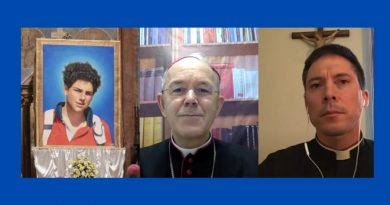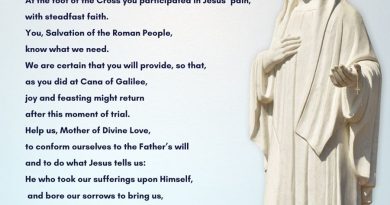Mary, the Mother of God, the Queen of Heaven – In the Bible
Published originally on Russia-Faith.com
It’s in the Bible . . . The Orthodox Church’s teachings about Mary, the Mother of God, are not extra-biblical additions to the Faith. Many of these teachings about Mary can be found in the Holy Scriptures themselves.
Before God became man, an important sign of God’s presence was the Ark of the Covenant.
In the wilderness, Moses placed it in the Holy of Holies. The Israelites crossed the Jordan River with it, and they marched around Jericho with it. King David danced before it. And after King Solomon built the temple in Jerusalem, the Ark was again placed in the Holy of Holies. The lid of the Ark was decorated with golden statues of angels, and a number of people were permitted to see the uncreated light of God, as the Shekinah glory literally shone between the wings of the cherubim.
Mary the New Ark of the Covenant
In the Book of Revelation, the Ark of the Covenant is described in connection with a highly exalted woman who gave birth to a great King:
Then the temple of God was opened in heaven, and the ark of His covenant was seen in His temple. And there were lightnings, noises, thunderings, an earthquake, and great hail. Now a great sign appeared in heaven: a woman clothed with the sun, with the moon under her feet, and on her head a garland of twelve stars. Then being with child, she cried out in labor and in pain to give birth. . . . And the dragon stood before the woman who was ready to give birth, to devour her Child as soon as it was born. She bore a male Child who was to rule all nations with a rod of iron. And her Child was caught up to God and His throne. —Rev. 11:19–12:5
As King David himself had prophesied in Psalm 2, the Messiah is the great King who comes to rule all nations with a rod of iron. He was born of a virgin, crucified, resurrected, and in the Ascension, he was caught up to God and His throne. In Revelation 12, this male child is Jesus.
And Mary is his mother. She is this great woman, clothed with the sun, with the moon under her feet, and on her head a garland of twelve stars. And ever since the very early days of the Church, Christians have recognized Mary as the fulfillment of the Ark of the Covenant. St. Hippolytus in the second century, and St. Gregory Thaumaturgus in the third, are among the many saints who have identified Mary with the Ark.
The Ark of the Covenant had some impressive contents:
-
Moses’ two stone tablets of the Ten Commandments
-
A jar of manna from the wilderness
-
Aaron’s staff which had budded with life
Mary herself being the new Ark of the Covenant, she contained the fulfillment of all these things:
-
Instead of God’s Word written in stone,
Mary’s womb contained the Word made flesh
-
Instead of manna from the wilderness,
Mary’s womb contained the Bread of Life
-
Instead of a staff from the first Levitical high priest, Mary’s womb contained the great High Priest himself, Jesus Christ, whose priesthood is after the order of Melchizedek
-
Instead of a budded staff symbolizing resurrection, Mary’s womb contained the Resurrection and the Life himself
Thus, it is fitting that the apostle John honors Mary and the Ark at the same time, and in the same breath. In the book of Revelation, St. John sees the Ark of the Covenant in the heavenly temple, and then he immediately describes this woman who gave birth to Christ, this woman who now wears the sun, moon, and stars for her clothing.
Just as we see early Christians identifying Mary as the new Ark, we also see early Christians recognizing Mary in the twelfth chapter of Revelation. In the fourth century, Epiphanius of Salamis mentions this passage in reference to Mary. And in the fifth century, in the oldest-existing Greek commentary on the book of Revelation, Oecumenius says the following:
“And a sign appeared in heaven, a woman clothed with the sun, and the moon was under her feet.” As I said, it is speaking about the mother of our Savior. And the vision appropriately depicts her as in heaven and not on the earth, for she is pure in soul and body, equal to an angel and a citizen of heaven. She possesses God who rests in heaven—“for heaven is my throne,” it says—yet she is flesh, although she has nothing in common with the earth, nor is there any evil in her. Rather, she is fully exalted, wholly worthy of heaven, even though she possesses our own human nature and substance.
—William C. Weinrich, Greek Commentaries on Revelation, p. 51
All True Christians are Royalty
When early Christians praise Mary in this way, and when Scripture itself gives her such great honor, there are still some people who wonder:
“Should any human being be honored in this way?”
“It makes sense that Jesus is King, because he is God. But Mary is not God.”
“Surely there is no king in heaven except Jesus, and surely heaven has no queen.”
Of course, it is true that Jesus is exalted far above everyone. He is God, and there is no man, woman, or angel who is equal with Him. He alone is God. You, me, Mary, and the Saints are all human beings who have been redeemed by God, being conformed to the image of Christ.
But what does it mean to be conformed to the image of Christ? If Jesus is a great king, and you are conformed perfectly to his image, that means you yourself will be a king (or queen). In fact, Scripture itself tells us this. Believe it or not, Jesus is not the only king in the Church. According to the fifth chapter of the book of Revelation, Jesus has redeemed us to God by his blood, out of every tribe and tongue and people and nation, and has made us kings and priests to our God. (Rev. 5:9–10)
In other words, Mary is not the only person in heaven to be exalted as royalty. Mary is queen, the apostles are kings, and by the grace of God, you and I will join their sides as both kings and queens. In God’s presence, every saint will be recognized as royalty. And Jesus alone will bear the title “King of Kings, and Lord of Lords.”
Mary is the Queen Mother
Revelation is not the only place in Scripture that recognizes Mary as the Queen of Heaven. We also see prophecies of her in the Old Testament Scriptures.
In Israel, many generations of kings were born in the Davidic line, pointing forward to the eventual birth of Jesus, the King of Kings. 2 Samuel 7:12, Psalm 72, and Psalm 89 were initially written about King Solomon, and later these Scriptures find their fulfillment in Christ himself. Solomon was the “seed of David” who reigned in peace, prosperity, and wisdom. Jesus is the ultimate “seed of David” who completely fulfills these prophecies.
But in Israel, they did not recognize the king’s wife as a queen. Instead, the king’s mother had this great honor.
Solomon had many wives, but only Bathsheba his mother was recognized as his queen. She was the Queen mother over Israel. She was subordinate to the King, to be sure. But she sat on a throne, and was granted the status of royalty and great political power.
Scripture doesn’t tell us the names of all the kings’ wives. But it does tell us who their mothers were. For hundreds of years, from the time of Queen Bathsheba, to Queen Naamah, to Queen Maachah, to Queen Azubah, to Queen Athaliah, to Queen Jehoaddan, to Queen Jecholiah, to Queen Jerusha, to Queen Abi, to Queen Hephzibah, to Queen Meshullemeth, to Queen Jedidah, to Queen Hamutal, to Queen Zebudah, to Queen Nehushta, the mothers of the Davidic kings retained this exalted status.
Also notice 1 Kings 2:19, where the Queen Mother is granted a royal place of honor, sitting at the right hand of the King. The King himself even rises in her presence, and bows down to her! He is still the King, but he shows his mother an immense amount of honor. Now think about Jesus, the long-awaited seed of David who will sit upon the throne permanently in the Kingdom of Heaven. If Jesus is the rightful heir to the Davidic throne, then who is the Queen Mother? It’s Mary.
Psalm 45 also prophesies of both King Jesus and his Queen. Hebrews 1:8 reveals that Psalm 45:6 is a reference to Jesus. And Psalm 45:9 refers to his Queen. Remember that the Queen in the Davidic kingdom was always the King’s mother, not the King’s bride. And since Mary is the mother of Jesus, Psalm 45:9 is a reference to Queen Mary.
So it is not surprising when we see Mary, the Mother of God, highly honored as a queen in the book of Revelation, clothed with the sun, with the moon at her feet, and a garland of twelve stars around her head. As the King’s mother, she is royalty.
The Dormition and Assumption of Mary
On this feast day (August 15th), we celebrate the Dormition of the Blessed Virgin Mary, and her bodily Assumption into heaven. She is the prototype for all Christians, as the first person literally to invite Jesus to live within her. Long before the 12 apostles walked and talked with Christ, Mary was already very close to her Son.
-
The apostles heard Jesus speak; Mary taught Jesus how to speak
-
The apostles ate food provided by Jesus; Mary fed Jesus with milk from her own body
-
The apostles saw Jesus sleeping on a boat; Mary rocked Jesus to sleep on her lap
-
The apostles walked with Jesus for 3 years; Mary walked with Jesus for 33 years
-
At the crucifixion, almost all the apostles ran away; Mary stood at the foot of the cross, beside St. John




